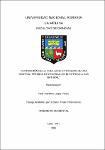Mostrar el registro sencillo del ítem
Estimación de la huella de nitrógeno de una central térmica de generación eléctrica a gas natural
| dc.contributor.advisor | Césare Coral, Mary Flor | |
| dc.contributor.author | Luque Valero, Paul Jhershon | |
| dc.date.accessioned | 2019-07-15T13:30:39Z | |
| dc.date.available | 2019-07-15T13:30:39Z | |
| dc.date.issued | 2019 | |
| dc.identifier.other | T01.L8-T BAN UNALM | |
| dc.identifier.uri | https://hdl.handle.net/20.500.12996/4028 | |
| dc.description | Universidad Nacional Agraria La Molina. Facultad de Ciencias. Departamento Académico de Ingeniería Ambiental, Física y Meteorología | es_PE |
| dc.description.abstract | El nitrógeno (N) es muy importante para la vida en el planeta Tierra, para la elaboración de proteínas, para el proceso de crecimiento y se necesita en muchas funciones metabólicas que se podrían ver truncadas por una deficiencia o falta de este elemento (Pierer et al., 2014). A todos los procesos naturales por el que este elemento pasa sucesivamente del aire al suelo, luego a los seres vivos y viceversa; se le conoce como ciclo de nitrógeno. Este ciclo en perfecto equilibrio ha sido capaz de mantener la vida en la tierra, satisfaciendo los requerimientos de ecosistemas y seres vivos. Sin embargo, a partir de la Revolución Industrial, el humano ha necesitado producir más nitrógeno. En consecuencia, los fertilizantes, la base de producción global de alimentos, proveen de N esencial al proceso de producción de alimentos (Pierer et al., 2014). Efectivamente, sin el nitrógeno que resulta del proceso de Haber Bosch, para fertilizar la tierra, más del 50 por ciento de la población mundial no tendría qué comer (Singh et al., 2015 y Erisman et al., 2008). Es así que hemos estado alterando el ciclo natural del nitrógeno, emitiendo formas de nitrógeno diferentes al N2, llamadas Nitrógeno reactivo (Nr). Llamaremos Huella de Nitrógeno a la cantidad de Nr que se emite al medio ambiente por las actividades humanas. En el Perú, según la Sociedad Nacional de Minería, Petróleo y Energía, el 42.9 por ciento de la electricidad en el Perú se genera con gas natural. Razón por la cual se buscó cuantificar la cantidad de Nr emitida por una actividad económica tan importante. Se determinó que se emite directamente un equivalente a 0.26091 Kg de N/MWh en base a las emisiones gaseosas de una unidad de una central térmica que opera a con gas natural. | es_PE |
| dc.description.abstract | Nitrogen (N) is very important for life on planet Earth, for the preparation of proteins, for the growth process and is needed in many metabolic functions that could be truncated by a deficiency or lack of this element (Pierer et al., 2014). To all the natural processes by which this element passes successively from the air to the ground, then to the living beings and vice versa; it is known as the nitrogen cycle. This cycle in perfect balance has been able to maintain life on earth, satisfying the requirements of ecosystems and living beings. However, since the Industrial Revolution, humans have needed to produce more nitrogen. Consequently, fertilizers, the basis of global food production, provide essential N to the food production process (Pierer et al., 2014). Indeed, without the nitrogen that results from the Haber Bosch process, to fertilize the land, more than 50 percent of the world's population would have nothing to eat (Singh et al., 2015 and Erisman et al., 2008). Thus we have been altering the natural cycle of nitrogen, emitting forms of nitrogen other than N2, called reactive nitrogen (Nr). We will call Nitrogen Footprint to the amount of Nr that is emitted to the environment by human activities. In Perú, according to the National Society of Mining, Petroleum and Energy, 42.9 percent of electricity in Peru is generated with natural gas. Reason why it was sought to quantify the amount of Nr issued by such an important economic activity. It was determined that an equivalent to 0.26091 Kg of N / MWh is directly emitted based on the gaseous emissions of a unit of a thermal power plant that operates with natural gas. | en_US |
| dc.format | application/pdf | en_US |
| dc.language.iso | spa | es_PE |
| dc.publisher | Universidad Nacional Agraria La Molina | es_PE |
| dc.rights | info:eu-repo/semantics/openAccess | en_US |
| dc.rights.uri | https://creativecommons.org/licenses/by-nc-nd/4.0/ | * |
| dc.subject | Nitrógeno | es_PE |
| dc.subject | Generación de energía | es_PE |
| dc.subject | Energía eléctrica | es_PE |
| dc.subject | Gas natural | es_PE |
| dc.subject | Ciclo del nitrógeno | es_PE |
| dc.subject | Polución | es_PE |
| dc.subject | Control de la contaminación | es_PE |
| dc.subject | Evaluación | es_PE |
| dc.subject | Perú | es_PE |
| dc.subject | Huella de nitrógeno | es_PE |
| dc.subject | Central térmica | es_PE |
| dc.subject | Nitrógeno reactivo | es_PE |
| dc.title | Estimación de la huella de nitrógeno de una central térmica de generación eléctrica a gas natural | es_PE |
| dc.type | info:eu-repo/semantics/bachelorThesis | en_US |
| thesis.degree.discipline | Ingeniería Ambiental, Física y Meteorología | es_PE |
| thesis.degree.grantor | Universidad Nacional Agraria La Molina. Facultad de Ciencias | es_PE |
| thesis.degree.name | Ingeniero Ambiental | es_PE |
| dc.subject.ocde | http://purl.org/pe-repo/ocde/ford#1.05.08 | es_PE |
| renati.author.dni | 72190521 | es_PE |
| dc.publisher.country | PE | es_PE |
| dc.type.version | info:eu-repo/semantics/publishedVersion | en_US |
| renati.advisor.orcid | https://orcid.org/0000-0002-6901-3171 | es_PE |
| renati.advisor.dni | 25731842 | es_PE |
| renati.type | https://purl.org/pe-repo/renati/type#tesis | es_PE |
| renati.level | https://purl.org/pe-repo/renati/level#tituloProfesional | es_PE |
| renati.discipline | 521066 | es_PE |
| renati.juror | Pacsi Valdivia, Sergio Artemio | |
| renati.juror | Quipuzco Ushñahua, Lawrence Enrique | |
| renati.juror | Visitación Figueroa, Lizardo |
Ficheros en el ítem
Este ítem aparece en la(s) siguiente(s) colección(ones)
-
CIE-IA Tesis [282]




